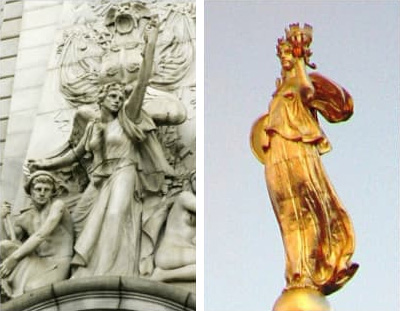5 People You're A Huge Fan Of Without Realizing It

You will never forget some people and their great deeds: Gutenberg and his press, Michelangelo and the Sistine Chapel, Donald Trump and the roiling pit of despair in your very soul, and countless others who have impacted your life in profound ways. Some of them, you've never even heard of. Let's celebrate five of those invisible others, shall we?
Carolyn Hopkins Tells You To Do ... Everything
You've no doubt heard a friendly, yet stern voice telling you to stand clear of the doors, how many stops you are from Times Square or, for the sake of God and country, stand to the right if you're just going to plant up on the moving walkways. And if you've ever paid close enough attention, you've noticed that the voice in question sounds awfully similar, whether it's booming at you in beautiful, meth-addled Spokane, or the ass-end of Long Island.
That's not because it's some hi-tech computer amalgamation of everybody's mom. It's the same voice: former Kentucky soul singer Carolyn Hopkins.
Her kids must have loved getting told what to do.
Once the lead singer of Louisville band the Chaparrals, Hopkins later used her voice talents to transition to Innovative Electronic Designs, better known by the unfortunate acronym IED. One of her first tasks was lending her soothing, yet cautionary voice to Disney's Typhoon Lagoon waterpark. In the decades since, she's become the voice of hundreds of airports, subway systems, ferries, production plants ... not to mention the Kennedy Space Center, and all 26 buildings at the U.S. Capitol. As she puts it, "I'm very good at telling people to get the heck out of a place when it's on fire."
The Sad But Predictable Story Of The Most '90s Pattern
If you're a child of the '90s, this is what you see when you close your eyes:

Filled with only the finest of Surge.
That's the Solo Jazz pattern and, for decades, no one really knew (or much cared) who was responsible for it. But finally, in a feat of investigative journalism that is as impressive as it is entirely pointless, Thomas Gounley, a reporter for Missouri's Springfield News-Leader, painstakingly tracked down the creator of the design: one-time artist for Sweetheart Cup Company, and now-time frame shop manager down at the Hobby Lobby, Gina Ekiss.

Back in 1989, the Sweetheart Cup Company needed a new stock design for their paper products -- one that wouldn't get disastrously thunderfucked every time the printer misregistered in the slightest. So they opened up a design contest to their 32 internal artists. A scribble met the single design requirement quite nicely, so that's precisely what Gina entered: a scribble of her two favorite colors. The submission won out, and Gina landed herself a hefty $0 bonus (but with an additional $0 in royalties!) for creating the company's single best-selling design. The rest is '90s history. Or wait ... uh ... "fresh, gnarly yester-times?" We forget how the past talked. Insert something suitably embarrassing here, if you remember.
Pen & Pixel Made Rap's Most Famous And Tacky Album Covers
Hip-hop may have been birthed in the '70s, and grew into its big-boy Adidas in the '80s, but it was the '90s when it truly found its stride. That's when all the disparate elements perfectly combined to form a multi-million album-selling Voltron: the attitude, the rebellion, the chronic, the East Coast/West Coast rivalry, the album covers ...

The mid- to late '90s gave us some of the gaudiest goddamned images in recorded history. And it wasn't a case of rappers copying each other's style: they just all employed the same design firm. That firm was Houston-based Pen & Pixel, the brainchild of these guys:

"We love rap!"
After proving themselves popular at Texas hip-hop label Rap-A-Lot (great name! Really tells you what they're about), brothers Aaron and Shawn Brauch set out on their own in 1992. Aaron was a Mensa-card-carrying MBA graduate from Cornell; Shawn held multiple design degrees and loved to scuba dive, a tidbit which is important here because only oxygen deprivation can adequately explain this:

Over the next 11 years, the duo served as many as 8,000 clients, producing a staggering 19,180 album covers. They mastered the art of taking everything a rapper had ever mentioned in history -- Bentleys, bling, honeys, cash, bears(?) -- and jamming it all onto a single album cover.

Ain't nothin' more hard than lady-salon hair dryers.
The firm worked with some of the biggest names in the business -- Snoop Dogg, Master P, Mystikal, and Lil Wayne, to name a few -- and their influence is apparent even today: When Wiz Khalifa unveiled the cover of his 2015 album Talk About It In The Morning, the homage couldn't have been clearer had it been carved entirely from diamond. Which it arguably was.

Marni Nixon Was The Voice Of Every Classic Hollywood Musical
Quick: What do Deborah Kerr of The King And I, Natalie Wood of West Side Story, and Audrey Hepburn of My Fair Lady have in common?

They all had an unhealthy gray pallor?
If you answered "big-time Hollywood producers thought they couldn't sing for shit," you win a prize! (It's a Godiva chocolate wrapper into which we've secretly placed a Dove chocolate. Fuck you.) Yes, in the case of each actress's most famous singing role, her voice was dubbed over by the pitch-perfect soprano of Marni Nixon -- a woman whose face you've likely never seen, despite the fact that she could've easily passed for Julie Andrews' stunt double.

Modern musicals prominently feature the actual actor's voice, even if that means risking the occasional Russell Crowe, but directors of the musical's golden age wouldn't stand for that shit. Nothing less than perfect would do, and perfect's name was spelled M-A-R-N-I. She lent her superhuman larynx to somewhere in the neighborhood of 50 films.
Of course, studio executives get off one bus stop before cartoon villainy, so this was all very hush-hush at the time. In fact, in payment for The King And I, Nixon received $420, zero royalties, and a threat to never work in Hollywood again should she ever speak of her role in the film. Leading lady Deborah Kerr, meanwhile, got an Oscar nomination and a swimming pool filled with molten gold (probably).

Secrets never last long in Hollywood, however, and word of Nixon's ghost singing gradually spread until, in 1961, she was able to fight for and receive unprecedented royalties from the West Side Story soundtrack ... which, by the way, became the best-selling album of both 1962 and 1963. She went on to spend her later years touring in a one-woman show entitled Marni Nixon: The Voice Of Hollywood -- a title which, in any other case, would be fairly presumptuous.
Audrey Munson Is Every Other Statue In Your City
Around the turn of the 20th century, a fortune teller gave young Audrey Munson a prediction straight out of Game Of Thrones: "You shall be beloved and famous. But when you think that happiness is yours, its Dead Sea fruit shall turn to ashes in your mouth."
Still, that didn't stop Munson from pursuing a career in the public eye. And it didn't take said eye long to notice that she was "the world's most perfectly formed woman." Ideal Grecian proportions, "fulsome" breasts, and a set of ass dimples you could do shots of Jameson out of. As such, she soon found herself serving as muse to an endless sea of artists -- and that's why, if you've ever strolled through New York City, you've probably seen her ... perched atop the Municipal Building. Or in the Pulitzer Fountain at the southeast entrance to Central Park. Or on the opposite end of Central Park, in the Maine Monument. Or at the Manhattan Bridge, or at the Brooklyn Museum, or at the New York Public Library. Suffice to say that if you've encountered a sculpture of a female in New York (or in any other major American city), you've probably come face-to-face with Audrey Munson.



Hell, she was even featured on money, an honor normally reserved for old men who appreciate a perfectly formed breast, not vibrant women who proudly possess a pair of them.

"But now we can look at boobs while we play with money!"
Tragically, Munson's immeasurable beauty was like a thin chocolate shell over a chewy center of shithouse crazy. She claimed to be a European aristocrat, naming herself "Baroness Audrey Meri Munson-Munson." She attempted suicide via poison. She petitioned the U.S. House of Representatives to pass a law specifically protecting her from the Jews. Then along came her 40th birthday, and with it the fulfillment of that age-old prediction: Munson was committed to an insane asylum in upstate New York, where she lived in obscurity until her death in 1996.
Anyway, the point is this: Don't go to fortune tellers. Best case scenario, you get something dissatisfying and vague; worst case scenario, you get an ironic curse.
Adam Koski's fantasy adventure book is eventually going to be more ubiquitous than all of these combined one day, so buy your copy now so you can start getting used to it!
Behind every awful movie is the idea for a good one. Old man Indiana Jones discovers aliens. Good in theory, bad in practice. Batman fights Superman. So simple, but so bad. Are there good translations of these movies hidden within the stinking turds that saw the light of day? Jack O'Brien hosts Soren Bowie, Daniel O'Brien, and Katie Willert of 'After Hours' on our next live podcast to find an answer as they discuss their ideal versions of flops, reboots, and remakes. Tickets are $7 and can be purchased here!
Also check out 6 Pieces Of Fan Art That Are Better Than the Original and 7 Fan Works So Good They Were Adopted By The Creators.
Subscribe to our YouTube channel, and check out 7 Mind-Blowing Details You Missed In Great Works Of Art, and other videos you won't see on the site!
Follow us on Facebook, and let's be best friends forever.